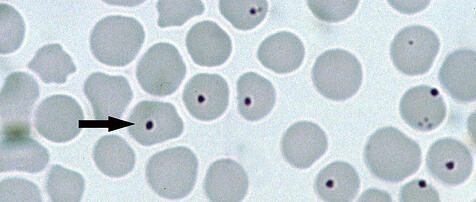If you were a bacterium attempting an invasion on a hostile immune system, would you be so bold as to consume the very cells that are trying to destroy you? At Ohio State University, researchers have just uncovered the methods of a strain of bacteria that does just that. This master spy, known as Anaplasma phagocytophilum, is only recently being understood and combatted against due to its insidious techniques.
Anaplasma phagocytophilum, or Ap for short, is known for transmitting the disease anaplasmosis to humans via ticks. What makes it special is that it avoids being destroyed by white blood cells by secreting a protein that binds them to the cells. The connection between the bacterium and the white blood cell creates small bubbles called vesicles that serve as packages of food that can feed the invading bacterium.

(Ap residing within white blood cells, courtesy of Wikimedia Commons and Alan Walker)
Why, though, is Ap so unique in this process? After all, if this bacteria can receive free food just for binding to a white blood cell, why don’t all bacteria do the same thing? Part of the secret lies in the production of the vesicles. Vesicles are produced when a cell is preparing for autophagy, that is, self-consumption. A white blood cell will prepare these packages of cell material that are non-essential to the normal cell functions if it is starving, or believes that it is starving.
The ace up Ap’s sleeve is the protein it uses to bind to white blood cells. Naturally, when a bacterium attaches itself to a white blood cell, the white blood cell receives an alarm signal that prompts it to destroy the invader. However, the “intruder alert” signal is very similar to the “I’m starving” signal, and the protein Ap secretes triggers the latter signal. This prompts the cell to instead create vesicles, which serve as delicious sustenance for Ap.
 In this way, Ap takes a natural defense process and manipulates it to its own advantage. The response that would destroy Ap instead feeds it, until the entire white blood cell is consumed. Ohio State University professor Yasuko Rikihisa (pictured left, courtesy of researchnews.osu.edu) believes this risky maneuver is a unique one to the world of bacteria:
In this way, Ap takes a natural defense process and manipulates it to its own advantage. The response that would destroy Ap instead feeds it, until the entire white blood cell is consumed. Ohio State University professor Yasuko Rikihisa (pictured left, courtesy of researchnews.osu.edu) believes this risky maneuver is a unique one to the world of bacteria:
“We believe this is the first bacterial protein that has been found to do this…They are creating their own food supply through a cellular mechanism that hurts other infectious bacteria. And because this process doesn’t cause inflammation, they do it very gently, becoming an insider that eventually kills the host cell.”
In an OSU article, Rikihisa discusses how her lab’s testing and imaging has yielded a possible defense against anaplasmosis, which has recently increased to afflict over a thousand people per year in the United States. By inhibiting vesicle production in Ap-infected cells, the lab found that “bacterial growth declined dramatically.” The next step is to release a non-toxic protein that can do this as a treatment for the public.
Discoveries of and treatments for bacteria like Ap garners funding from multiple sources for Ohio State University. For example, this particular study was supported by a grant from the NIH. To see a complete funding report for Ohio State University, please click the button below:
Biotechnology Calendar, Inc. will be on the Ohio State University Campus next on August 8th, 2013 for our Columbus BioResearch Product Faire™ event. This show is an excellent opportunity for life science scientists and laboratory equipment suppliers to network and discuss their research needs and solutions. To see our 2013 show schedule, click here. To attend the Columbus BioResearch Product Faire™ specifically, click this button:



